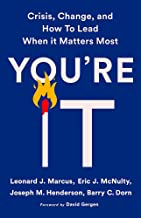By William Carmichael
Crises management has become rather perfunctory of late. Since the catastrophic events of 9/11, organizations of all sizes have created teams to handle emergencies with the hope their team can effectively manage whatever contingency comes their way. Dangers are anticipated, team leaders and experts are selected, procedures are written, mock drills are conducted, and at face value, readiness appears sufficient. The reality however, is that without the singular development of a “Meta-Leader” mindset; one who is specifically prepared to lead the organization through any challenge or change, traditional crises management is worthless. Now don’t get me wrong. All companies need and should have a crises management process but what typically is missing is the leadership mentality and skillset that makes You’re It; Crisis, Change, and How to Lead When it Matters Most by Leonard J. Marcus, Eric J. McNulty, Joseph M. Henderson and Barry C. Dorn so needed. A book for turbulent times, You’re It is essential reading for anyone preparing to lead through crisis and change.
Leading in Crises
By definition, a crisis is any event that is going to lead to an unstable and dangerous situation affecting an individual, group, community, or whole society. As a lead-in, this certainly describes the catastrophic events of 9/11/2001 but let’s not forget the first attempt to blow up the World Trade Center in 1993, Hurricane Katrina, the H1N1 pandemic, the Deepwater Horizon oil spill, or the Boston Marathon bombing to name just a few. Natural or man-made, each was devastating to our country and each required a dedicated response by individuals trained to lead under frightening circumstances. To lead following such devastation requires specific mental skill-sets to be sure.
But these same attributes can also be applied within business and organizational crises and this is what the authors have conveyed in You’re It. Here they have effectively documented what works and what doesn’t during an organizational emergency. Distilled from the best practices of Harvard University’s innovative Natural Preparedness Leadership Initiative, You’re It provides leaders with a practical, research-based foundation for thinking and acting with clarity, intention, and confidence in the face of crises. The reader is also given examples of how leaders in the corporate world have dealt with issues such as product recalls, strategic transformations, natural disasters and financial shortfall. The authors show how to navigate through a crisis, how to identify it, what to do, and how to lead and get the best out of people in your team or organization. In essence, how to develop Meta-leaders.
What is a Meta-leader?
In short, a Meta-leader is a leader of leaders. Meta-leaders reach across organizations and sectors to build cross-cutting strategies. They exchange information, share resources, and coordinate systems and personnel. They use their influence and connections to guide a cooperative course of action. With this as a base, the authors introduce readers to the pragmatic model and methods of “Meta-Leadership.” They show you how to understand what is happening during a moment of crisis and change, what to do about it, and how to hone these skills to lead high-performing teams so that when crisis hits, you can pivot to be the leader people follow when it matters most.
Ultimately, “Meta-leadership” is the framework to develop one’s leadership skills and it consists of three dimensions:
- The Person- you the leader
- The Situation in which you lead
- Connectivity in the network of stakeholders you lead
According to the authors, you, the leader, have to weave these three together which You’re It does extremely well through asking a specific set of open-ended questions at the end of each chapter; such as- How do you define yourself as a leader? Do you have emotional intelligence? Then, what is the situation? Do you have the ability to assess what is happening and what to do? And finally, connecting the right people within your group and beyond your organization to find and create a common purpose. As one advocate prefaces; “This is a book that takes us beyond the clichés of leadership literature, and provides tools that will make us smarter, more self-aware, and better prepared to when we are tested.” I could not agree more.
Structure and Layout
Throughout You’re It; Crisis, Change, and How to Lead When it Matters Most, an odd sense of familiarity will tug at readers but in a most profound way. You’ve been there. You know what happened as well as the result. What will not be familiar are the players, what was going on behind the scenes and why action occurred as it did.
You’re It has the look and feel of a textbook while containing the flexibility of a field guide. At 256 pages, each of its 14 short chapters uses simple, effective illustrations throughout to bridge concept correlations. And like a textbook, readers will benefit most by a linear approach and the engaging ‘Questions for Journaling’ that end each chapter.
Who Will Benefit Most from This Book?
Senior management and organizational leaders. Crisis management teams.
About the authors:
Leonard J. Marcus is founding codirector of the National Preparedness Leadership Initiative (NPLI), a joint program of the Harvard T.H. Chan Schools of Public Health and the Harvard Kennedy School of Government. Eric J. McNulty is NPLI associate director and instructor at the Harvard Chan School. Joseph M. Henderson is distinguished senior fellow at the Harvard Chan School and is on the NPLI faculty. Barry C. Dorn is senior advisor of the Program for Health Care Negotiation and Conflict Resolution at the Harvard Chan School and NPLI faculty member.

Professor | Strayer University william.carmichael@strayer.edu www.strayer.edu
